说明:
一、项目背景
地域风貌
竹文化馆项目所在的四川省宜宾市长宁县,拥有73万亩竹林、485种竹种和45km2的蜀南竹海景区,发展生态旅游极具优势。当地人以小规模耕作为生,以宗族为单位聚居;这些聚落伴随田地及水、树、竹林分散在平原上,通过道路、灌渠链接,这种四川特有的社区形式,被称为“竹林盘”。
灾后重建
2019年6月17日,长宁县发生6级地震,造成5822间房屋损坏,多处道路塌方,除安置住宅之外,该地亟需建设公共设施,促进经济复苏。基地所处的老城区格局保存完好,但80%的建筑不能继续使用,道路难行,预算紧张、建设周期短。
二、设计理念
场地布局
设计尊重原始地貌并保护生态环境,再现了簇群状的“竹林盘”空间肌理,将建筑体量拆分成三个大小不等的单体,紧凑布局,掩映于四周环绕的竹丛中,遵循建筑自然生长的逻辑,唤起人对自然的感知。
竹材物性
作为灾后重建项目,竹文化馆需要考虑如何就地取材、合理用材,减少现场施工时间,采用最有效发挥材料特性的结构形式。竹材圆形中空、纤维致密,质轻而强度高,结合柔性构造可以吸收地震冲击,作为结构材料的顺纹抗压力、抗拉力均具优势。因此设计选择原竹绑扎的拱结构,对竹子受弯的张力状态进行刻画,将竹材物性的真实表达作为其形态的逻辑。
三、设计创新
竹构创新
作为当地的重要文化节点,竹文化馆需要可灵活布局、可容纳各种文化活动的高大空间,与传统竹构空间相比,它需要更具公共性的规模尺度,因此项目采用绑扎成束的内接竹,突破单根竹材长度对于其跨度和高度的限制。
竹拱采用经挑选的直径80mm的原生竹子,每22根固定为一组。竹材经防腐浸泡处理,绑扎成束后柱础结合现浇混凝土固定,并烤弯定型、依次叠加形成嵌套的双螺旋结构组合形式,形成流动、往复、自然的内部空间。最小拱跨度25.7米,最大拱跨度42.7米,小跨度拱为大跨度拱提供支撑,保持了不同跨度拱的截面尺寸的一致性。
复合体系
竹材较小的弹性模量会产生不可忽视的变形量,在作用点之外出现反向弯曲的趋势;因此设计在水平方向增加檩条形成环箍,抑制主体结构的竖向变形,同时限制其横向位移;在此基础上将两层交叉斜向的竹篾编织成网格,利用蒙皮效应进一步增加整体刚度,三种层次的构件共同构成复合强化的结构系统。
专业一体化
竹文化馆设计重点关注了竹构与幕墙、机电系统的连接与融合的技术措施。针对竹结构变形量大的特点,设计将幕墙体系与结构体系脱离,以可变的弹性节点连接来减弱结构变形对幕墙体系的挤压作用。设备管线消隐于建筑的主体结构之中,利用更替层与结构竹拱之间的空隙作为管线出户、入户的路径;室内设备统筹布设于幕墙与屋面间的视觉盲区,最大化保持了材料原真性与空间完整性。
延续生命周期
建筑的结构体系均采用原竹,屋面构造辅助以竹篾,表层竹稍是竹子的枝丫部分编织而成,充分利用了竹材除主材外的剩余部分。竹建筑在全生命周期中的碳排放仅为同体积混凝土建造的2%,并可直接回收处理。
屋面竹稍的耐候性较好,寿命长达20年,并可在建筑的使用年限内可进行更新。由于室外的竹受温度、湿度变化影响而产生的霉变或爆裂会缩短建筑使用寿命,设计将暴露于室外的竹拱部分与内部结构表层脱离,与防水卷材结合,可通过维护和替换表层部分,使建筑整体的生命得以延续,也可降低后续运营维护成本。
降低能耗负荷
建筑造型在螺旋的两端天然形成了两个相对的开口,辅以竹材遮阳格栅,提供自然柔和的采光;玻璃幕墙开窗实现了整个空间的自然通风,既减少制冷能耗负荷,又保证了空间的舒适性和节能要求。自然材料具有天然的保温功能,相对同体积混凝土建筑,采用的构造可节省20%的保温材料。
生态友好
本项目避免了庞大的土方工程,最大限度保持了城市生态完整性,材料运输和存放过程中对周边生态基本不造成污染。原真的室内空间,无吊顶、涂料墙面,极大程度上减少了板材、胶等内装用料中挥发性有害物质对健康造成的影响。
四、项目意义
灾后经济恢复
由于竹材处理、结构定型、竹篾编织、茅草修整等施工过程依靠传统技术,项目有大量当地经验丰富的竹艺工匠参与,伴随大量手工营造技艺的运用,为当地手工业者提供一种灾后迅速重就业的途径。
社区纽带重构
作为灾后重建建筑,设计充分基于抗震性能选择材料,将建设周期控制在四个月,成为当地灾后第一批开放的公共建筑之一;建成后内部通透的大空间被用来展示竹工艺品、举行元宵节展会和当地舞蹈表演等活动,为社区提供可灵活使用的、轻松近人的社交空间。
地域身份认同
竹资源及竹文化是长宁的名片,然而此前长宁的文化建筑仅仅将竹材用于装饰,并未完全展示这种材料的巨大潜力;竹文化馆在当地是首次以建筑结构语汇表现了竹文化,可以让来此的游客更好地理解地域特色,也有助于居民对于地域身份的认同。
Site and context
Bamboo Forest Plate Landscape
The project is located in Changning County, Sichuan Province, with 487 km⊃2; of bamboo forests, 485 bamboo species and 45 km⊃2; of the Shunan Bamboo Sea scenic area, which is highly advantageous for the development of ecotourism. Dispersed on the plains with fields, water, trees and bamboo forests, local people live by farming and live in clans consist of dozens to hundreds of households, which is unique in Sichuan known as the "Bamboo Forest Plate".
Post- earthquake Reconstruction
On June 17, 2019, a magnitude 6 earthquake occurred in Changning County, causing damage to 5,822 houses, and varying degrees of problems in ecological landscapes and community connections. Therefore this county is in dire demand for landscape restoration, construction of public facilities and economic recovery. The old town the site located is well preserved in pattern , with 80% of the buildings no longer usable, the roads difficult to navigate, and limited budget and construction period .
Architectural Concept
Overall Arrangement
Respecting the original regional landscape and re-creating the spatial texture of the cluster-like "Bamboo Forest Plate", the design splits the building into three units of different sizes with a centralized arrangement, which is hidden in the surrounding bamboo bushes, to preserve and restore the ecological environment and evoke a sense of nature by following the logic of natural growth of buildings.
characteristics of bamboo
The design take the efficiency into account to minimize construction time and adopt structural forms that most effectively utilize the characteristics of materials. Bamboo is light and strong, with outstanding toughness, it can absorb seismic shocks in a flexible structure . Therefore, a tensile arch structure is selected to utilize the material efficiently , poetically characterize the strong tenacity of bamboo, and to enable the building to withstand earthquake damage.
Design Innovation
Structural Composition
As an important public center of the town, the building provides a large flexible space that can accommodate local cultural activities. Compared with traditional bamboo buildings, this project requires a more communal scale, so that we use bundled jointed bamboo to break the limits of the length of single bamboo and achieve a large span and height. The arches are made of selected native bamboos with a diameter of 80mm, with each 22 fixed in a group. After anti-corrosion treatment, they are fixed at the base of concrete, formed by fire baking, and then stacked in turn to form a double helix. With a minimum span of 25.7 meters and a maximum span of 42.7 meters, these arches loop around the building to interact with the interior column-free space.
Reinforced Structural System
The spatial overlap of the bamboo arches links the discrete structural units into a whole system, creates a fluid, reciprocal, natural internal space, and enables the small-span arch to provide support for the large-span arch, maintaining the consistency of the cross-sectional dimensions of arches with different spans. The stress forced on arches can cause a significant bending deformation due to the small elastic modulus of bamboo, therefore we add purlins in the horizontal direction to form a ring hoop to inhibit the vertical deformation of the main structure while limiting its lateral displacement. Two layers of crossed bamboo strips are woven into a grid to increase the overall stiffness by diaphragm effect. Three types of components constitute a composite reinforced structural system.
Integrated Design
In response to the large deformation of bamboo structures, the curtain wall system and structure are detached and combined with elastic variable nodes to reduce the extrusion caused by the deformation. The equipment piping is concealed between the replacement layer and the structural bamboo to exit and enter the building, and the interior equipment is arranged in the invisible area between the curtain wall and the roof to keep the originality of the material and the integrity of the space. Covered by bamboo sunshade grilles, the two openings of the spiral space provide natural light and ventilation throughout the whole space, ensuring the comfort and energy efficiency of the building.
Utilization and Recycling
The project adopts independent foundation under each arch, which greatly reduces the excavation of the land and the damage to the vegetation, and the materials, compared with the industrial building materials, basically do not pollute the surrounding ecology during transportation and storage.
The structural system of the building is made of raw bamboo, the roof structure is assisted by gabions, and the surface layer of the bamboo is woven from the branches of the bamboo, making full use of the remaining part of the bamboo material other than the main material. The carbon emission of bamboo building in the whole life cycle is only 2% of the same volume of concrete construction, and can be directly recycled.
Environment and Energy
The building shape naturally forms two opposite openings at the two ends of the spiral, supplemented by bamboo sunshade grilles to provide natural and soft lighting; the glass curtain wall openings realize natural ventilation of the entire space, which not only reduces the cooling energy load, but also ensures the comfort of the space and energy saving requirements. Natural materials have natural heat preservation function, relative to the same volume of concrete buildings, the structure used can save 20% of the insulation material.
Reduction of Pollution
Bamboo structure forms the original real indoor space without ceiling and paint wall, which greatly reduces the impact of volatile hazardous substances in the interior materials such as panels and glues on health.
Protection of Ecology
The project adopts independent foundation under each arch, which greatly reduces the excavation of the land and the damage to the vegetation, and the materials, compared with the industrial building materials, basically do not pollute the surrounding ecology during transportation and storage.
Significance of the project
Post-earthquake Economy
As the construction of bamboo treatment such as structural shaping, gabion weaving, and thatching relies on traditional techniques, the project involves a large number of experienced local bamboo handicraftsmen, provides an avenue to quickly rejoin the workforce after earthquake.
Community Connection
As a post-disaster reconstruction building, the design is fully based on the seismic performance of the selected materials, which helps to improve the seismic capacity of the building, to control the construction period in four months, and become one of the first public buildings opened after the earthquake. The large interior space is used for activities such as bamboo crafts exhibitions , Lantern Festival fair, and local dance performances. It will continue to provide the community with a flexible and relaxing social space.
Regional Identity
Bamboo resources and culture are the regional identity of Changning, however, the current cultural buildings in Changning with bamboo used only for decoration, does not show the great potential of this material.This project express bamboo culture with architectural vocabulary for the first time ,which helps tourists to better understand the regional characteristics, and helps the residents to identify with the regional identity.
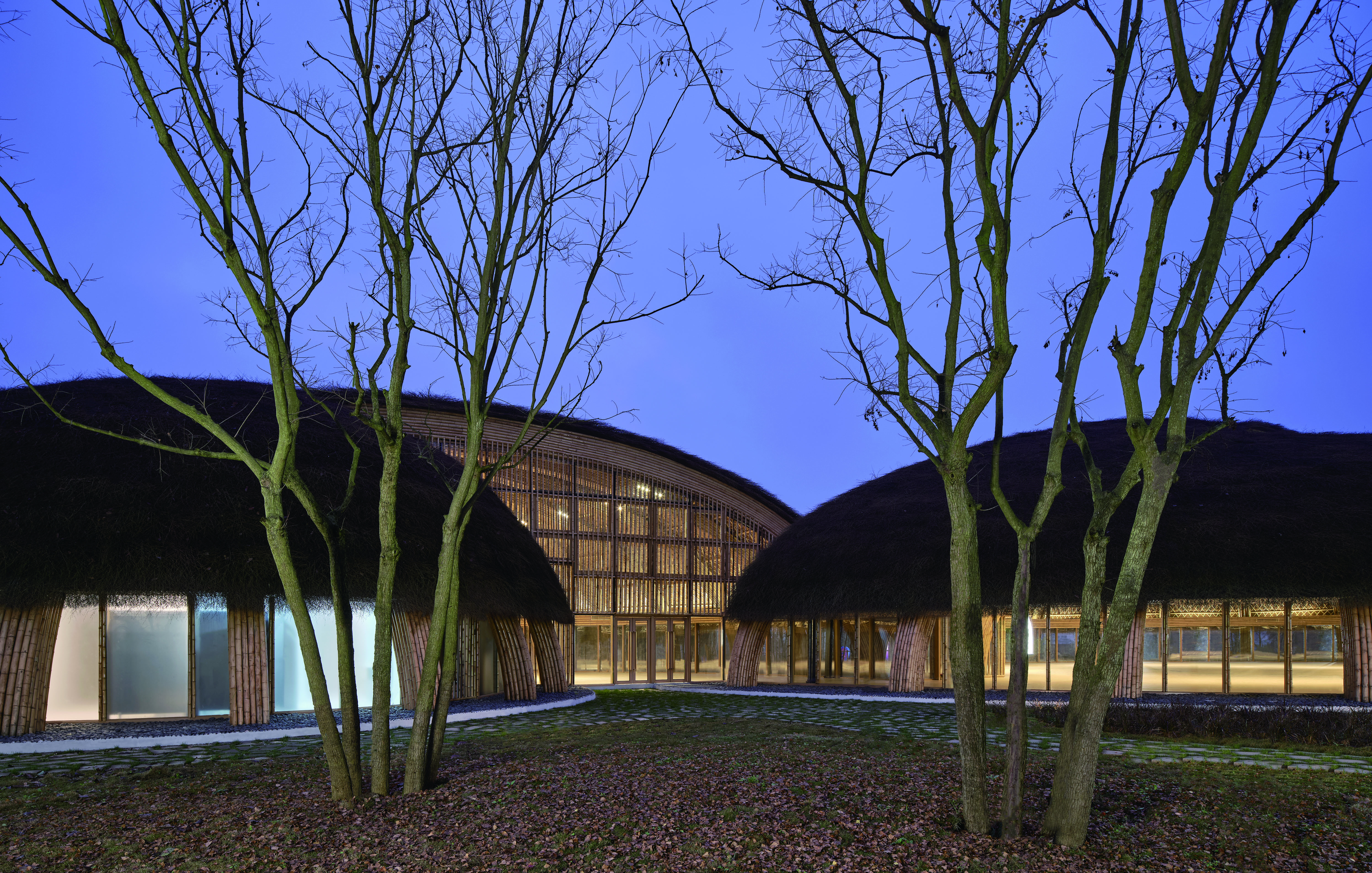
透明性因功能而异-Varying degrees of transparency for different functions
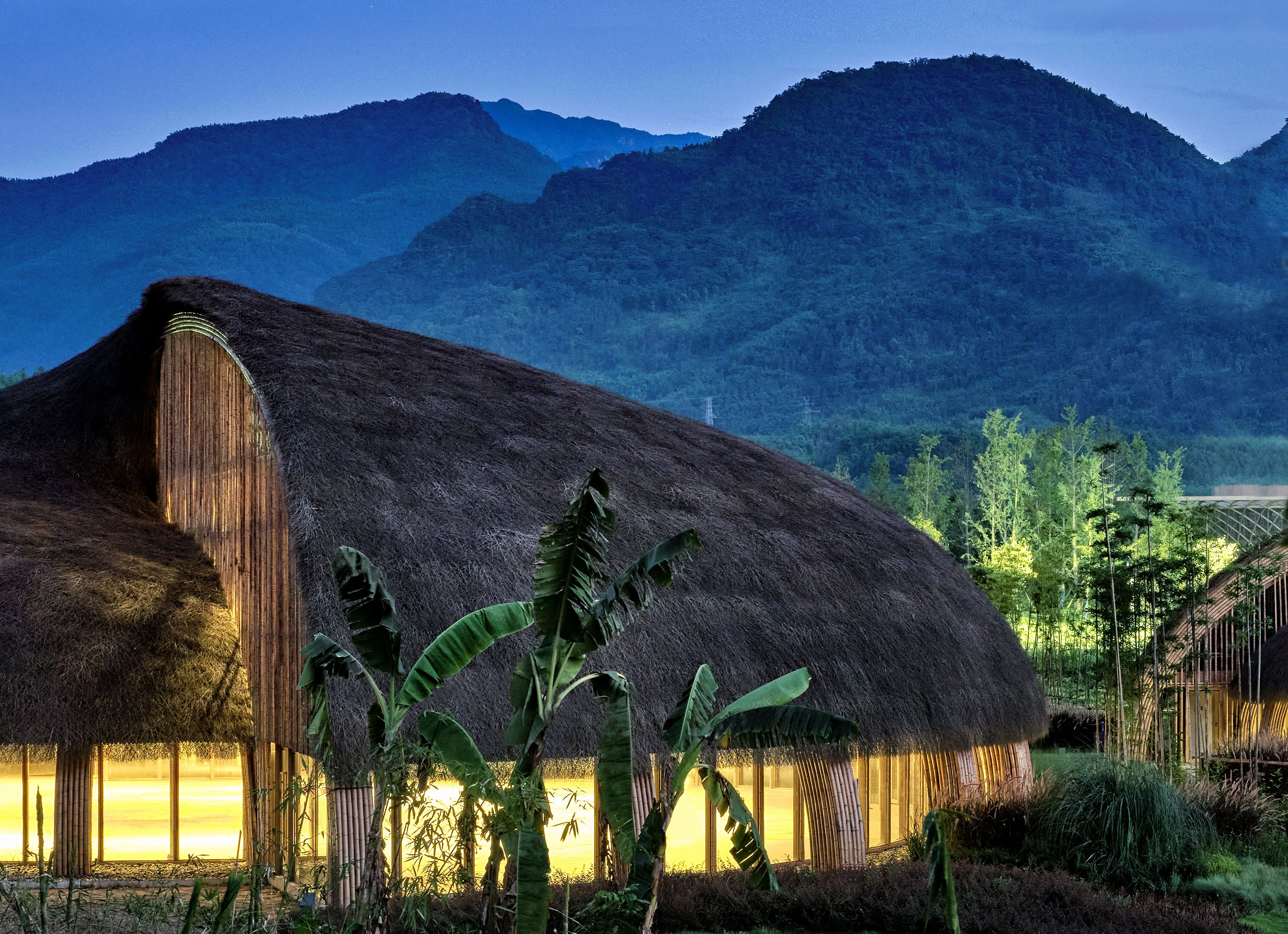
屋脊回应山形-The roof echoing the mountain outline
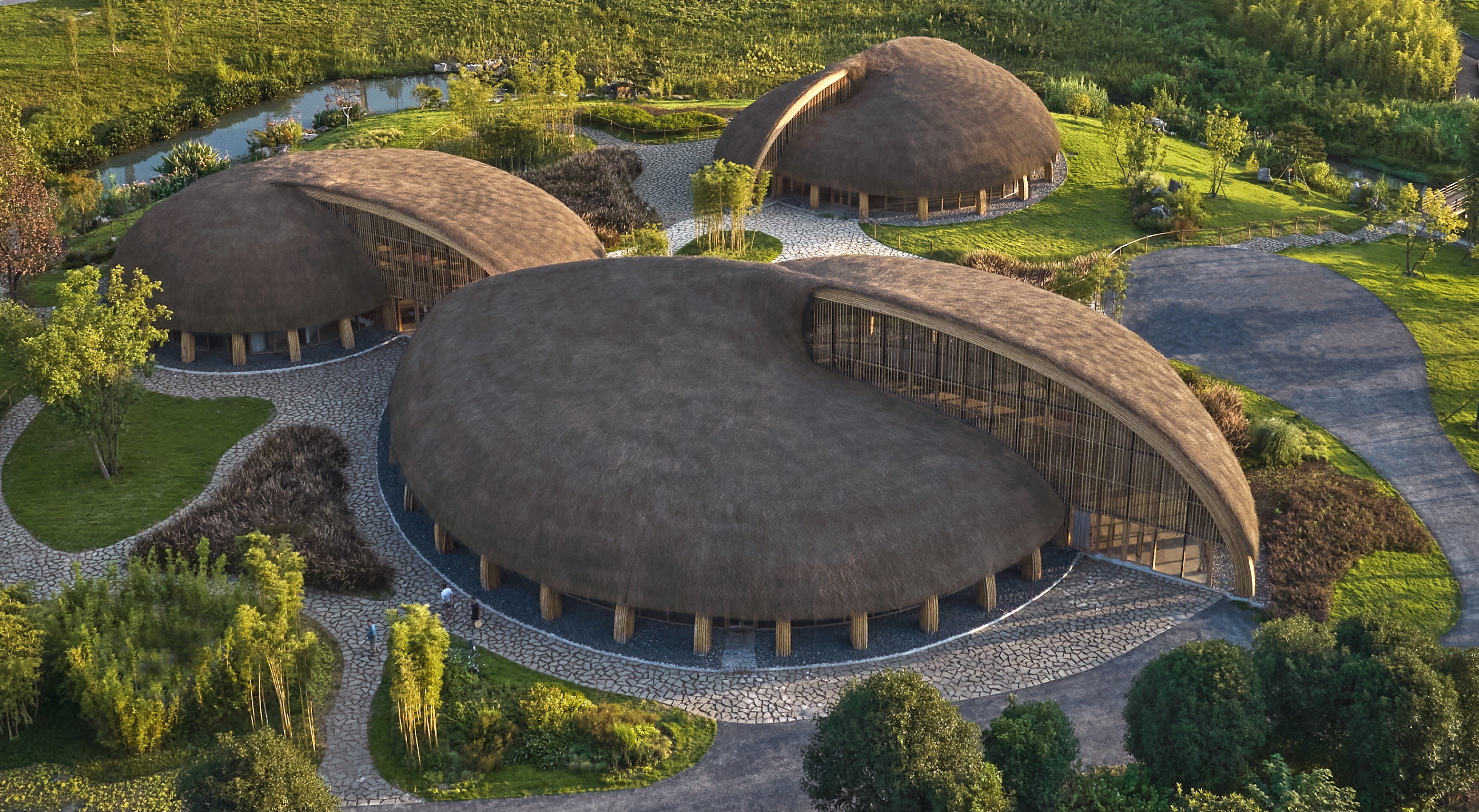
“竹林盘”般的布局-Architectural composition resembles the bamboo forest platelandscape
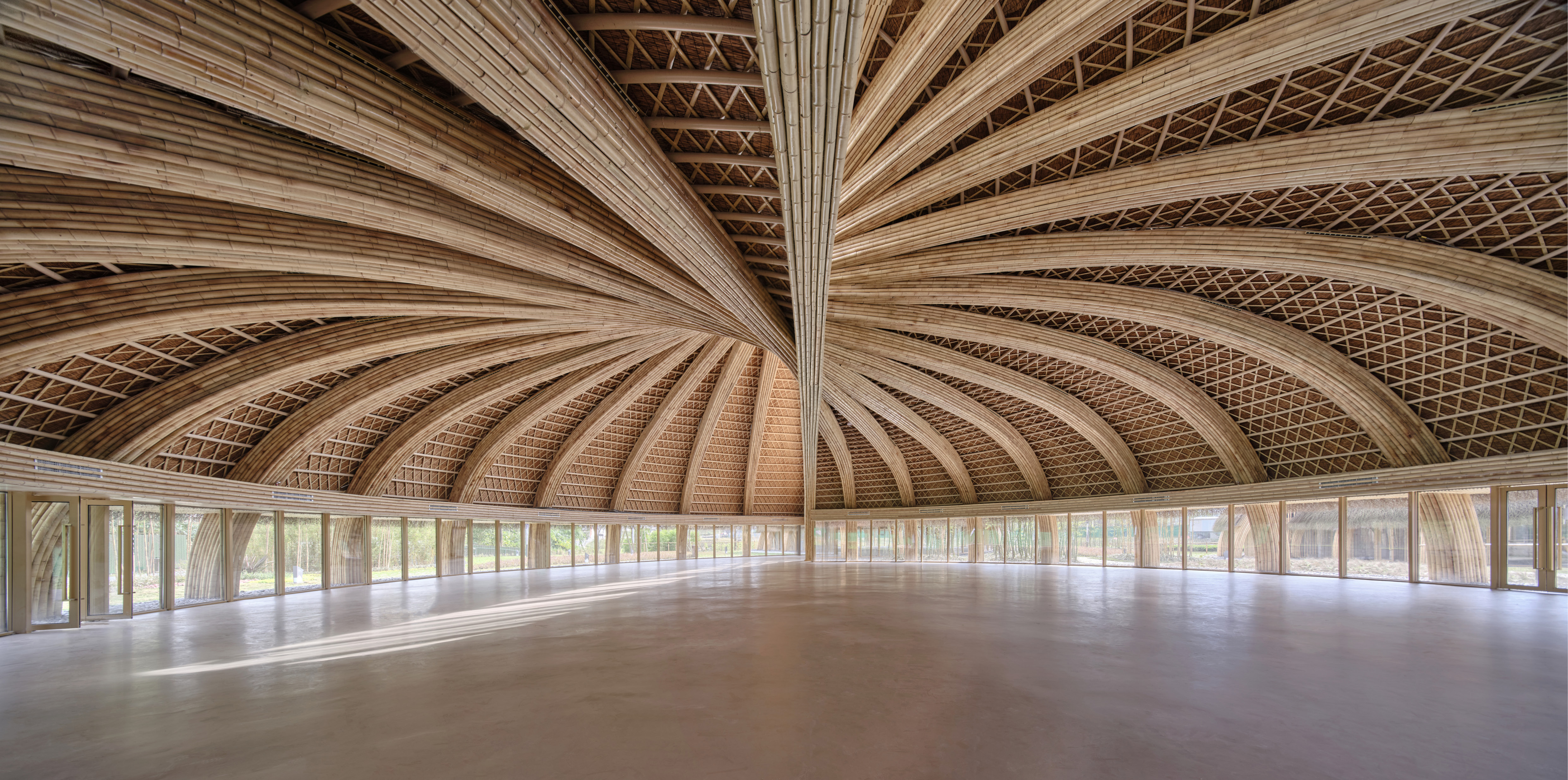
展厅双螺旋空间-Two opposite half in a balance
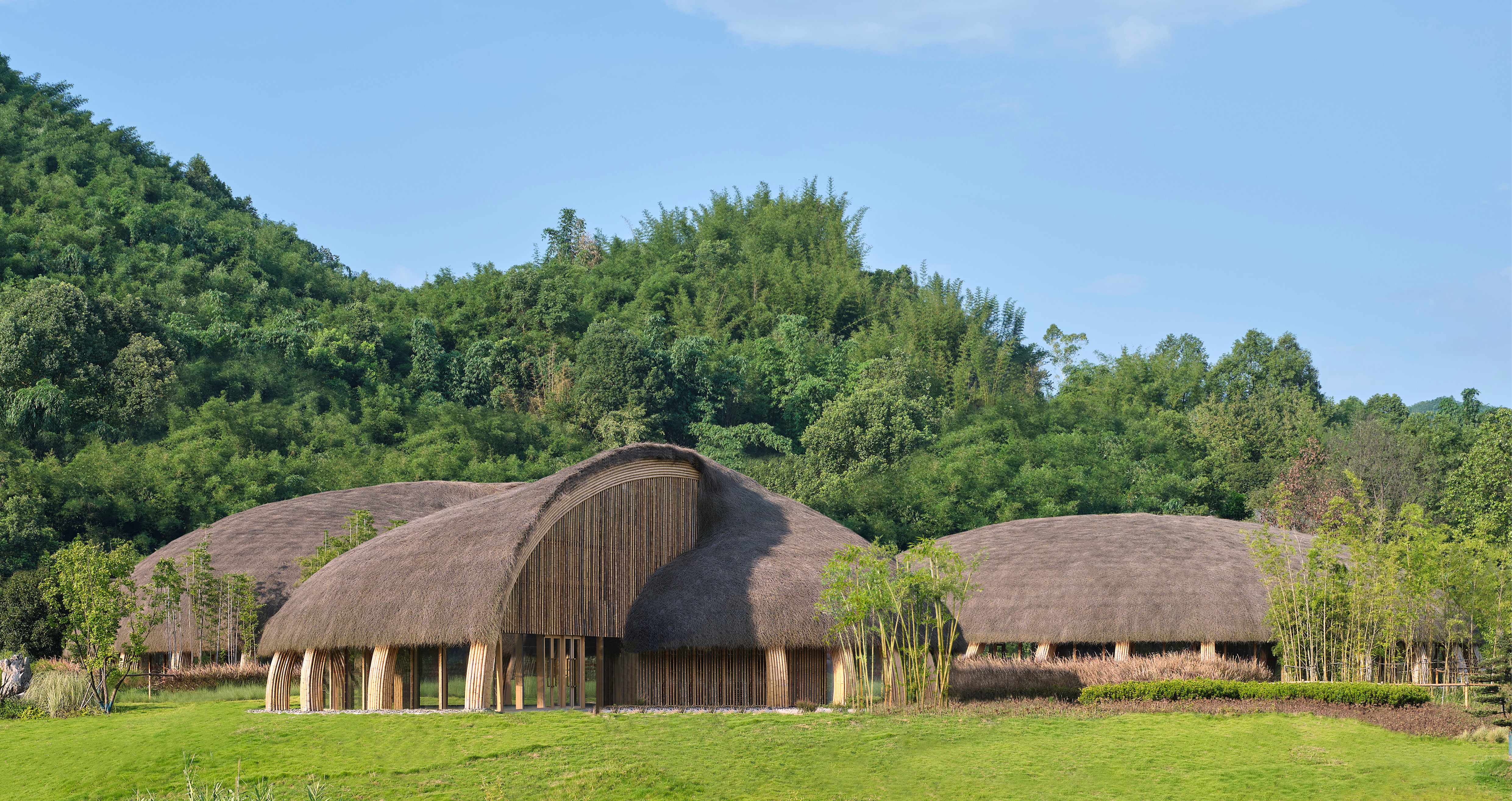
建筑融于周边环境-The architecture becomes an organic part of environment
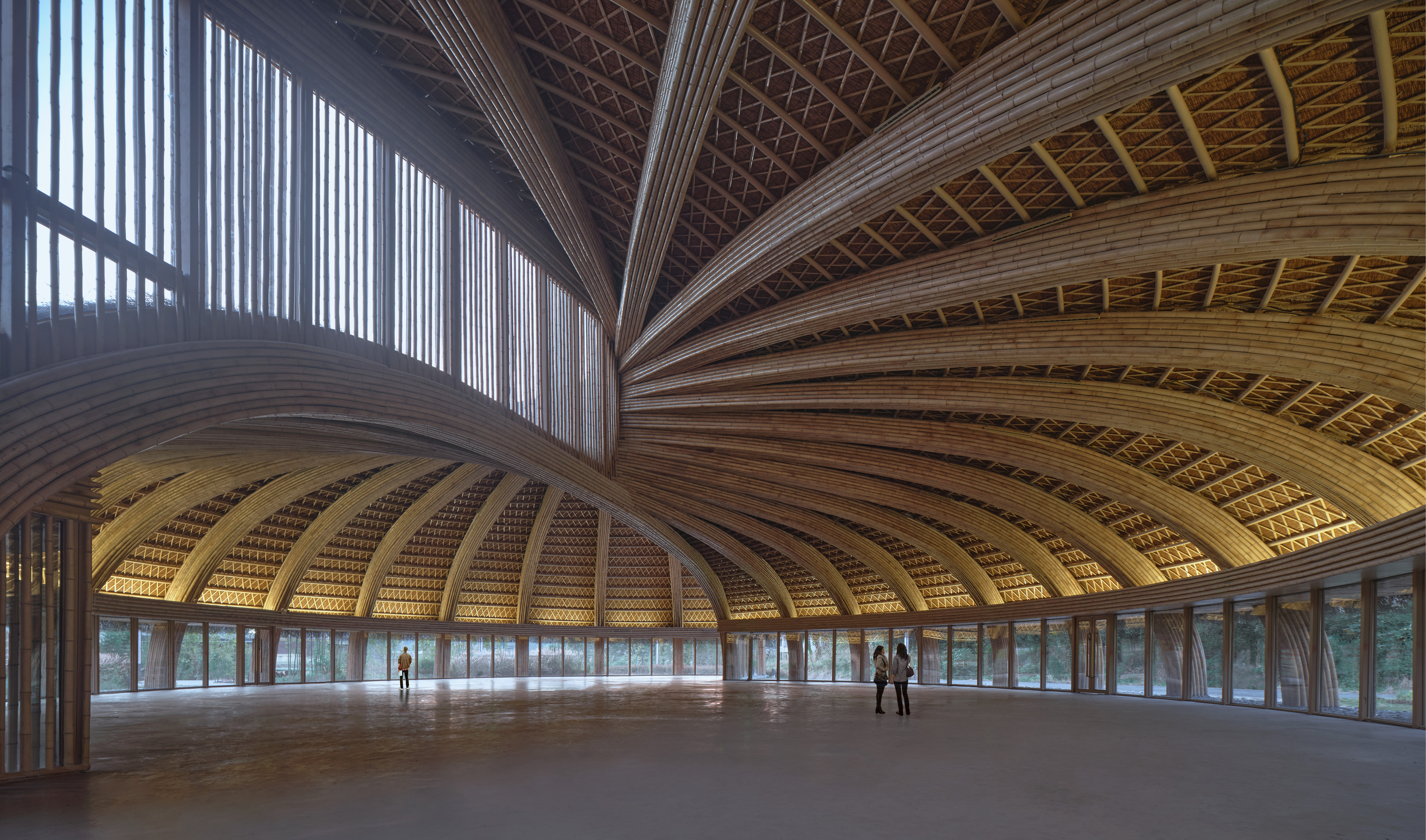
小跨拱支撑大跨拱-Large-span arches on small-span arches for the consistency of cross-sectional dimensions
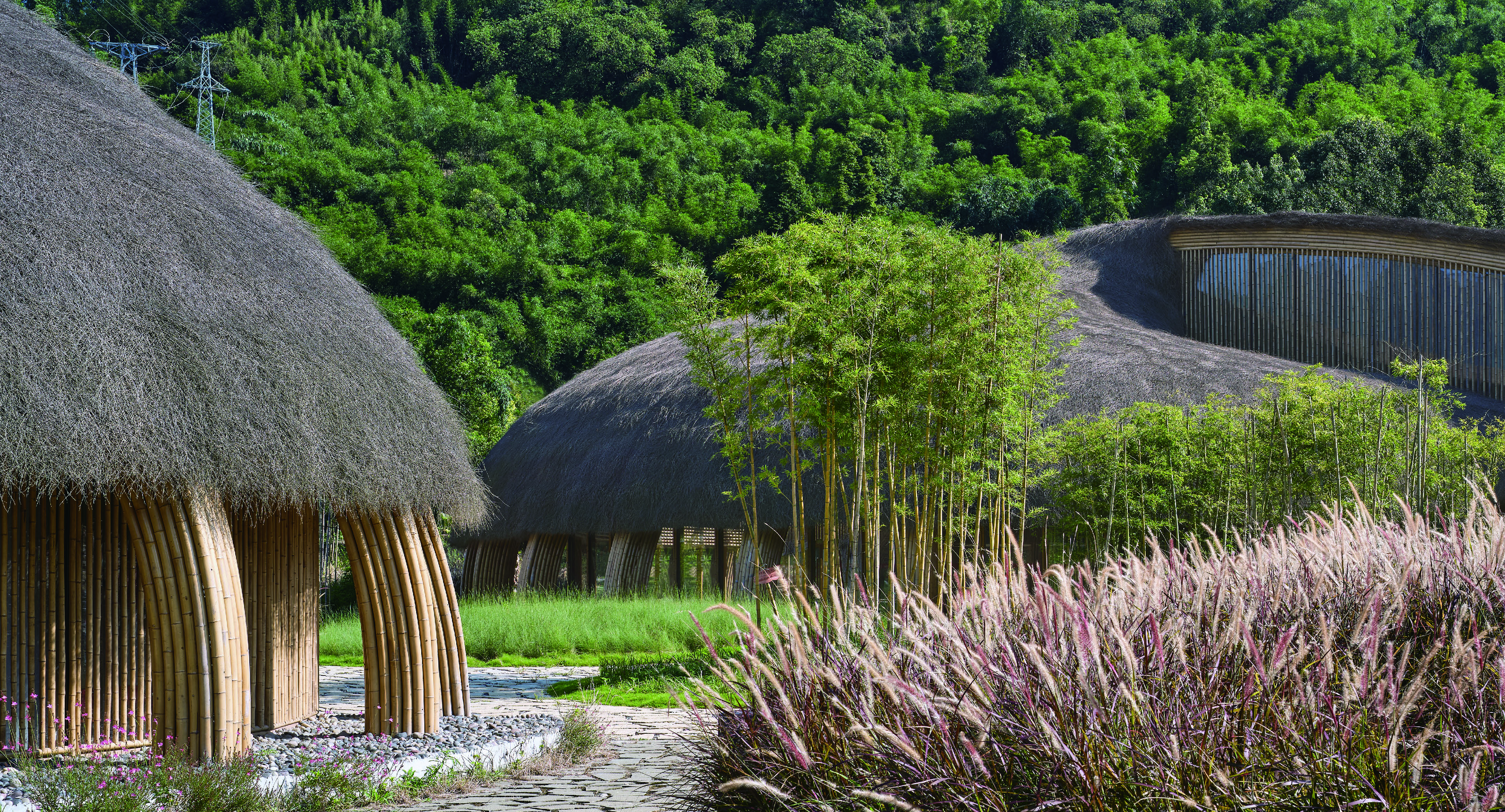
竹与竹屋互相掩映-The architecture and bamboo covered by each other

茶室室内-Interior space of tearoom

双螺旋结构-Double helix structure

竹拱通廊-Arched exterior corridor

构造细部-Detialed joints
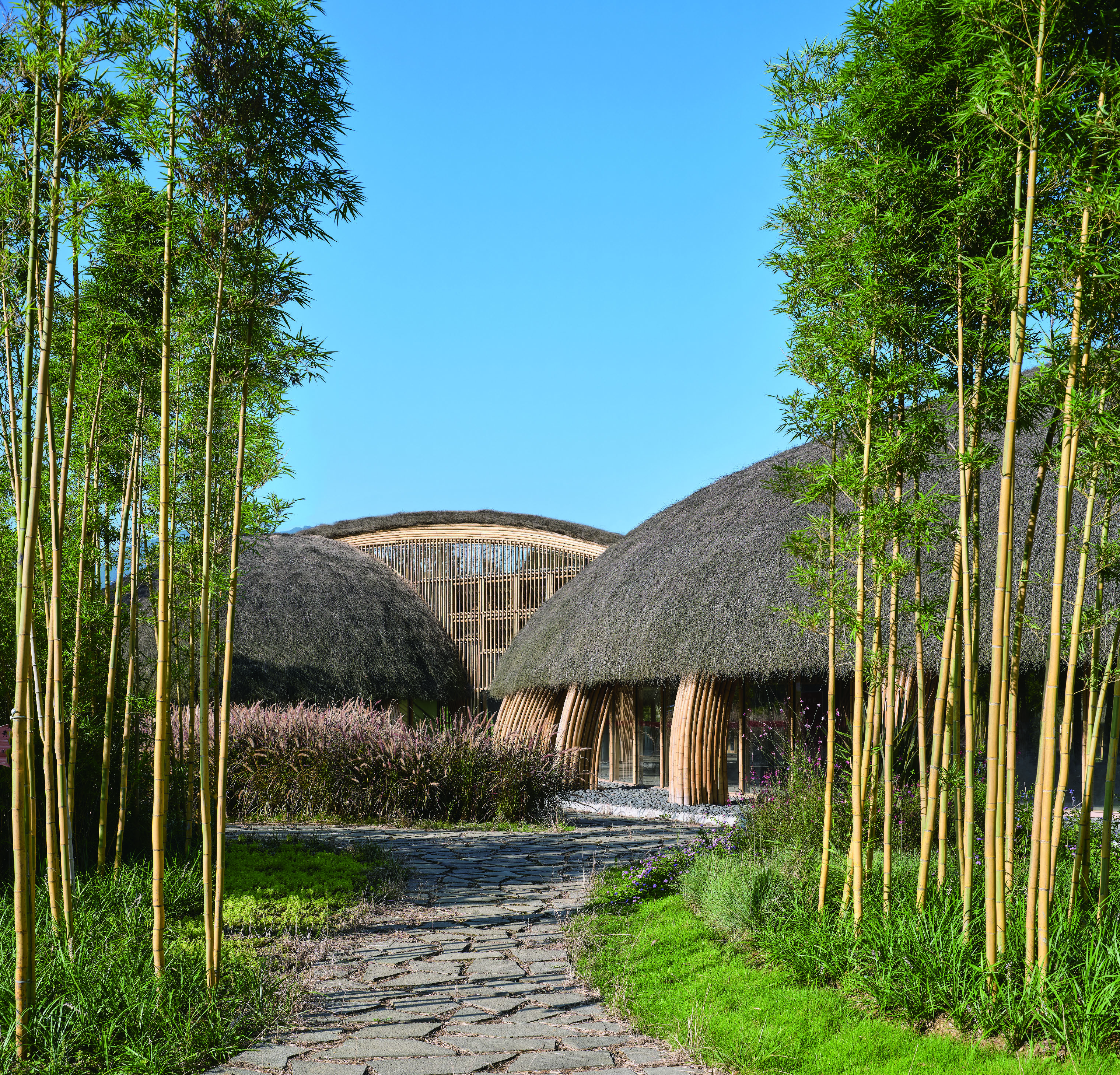
室外展示空间-Natural outdoor museum for various local bamboo species
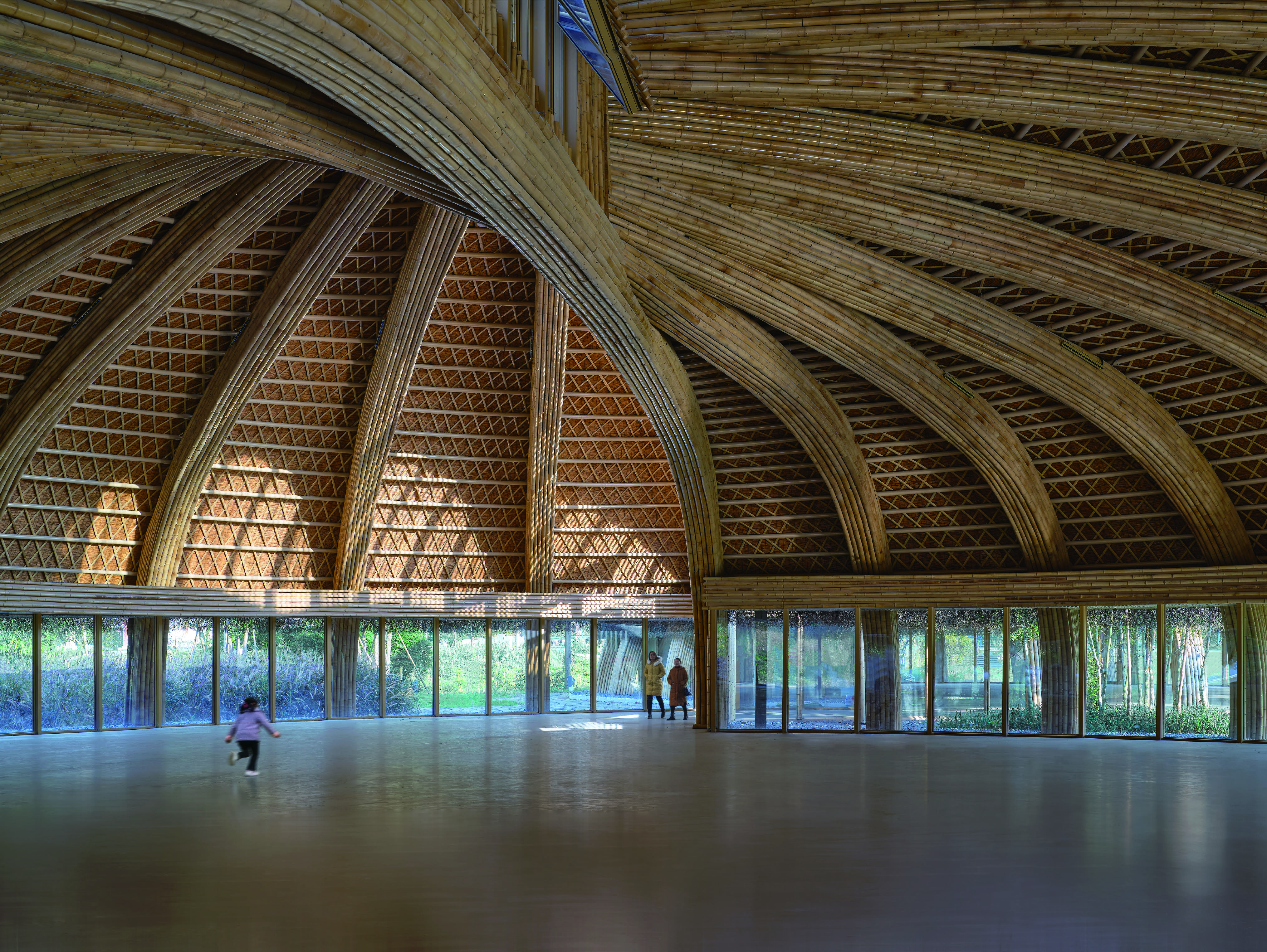
竹拱叠合-The spatial overlap of bamboo arches
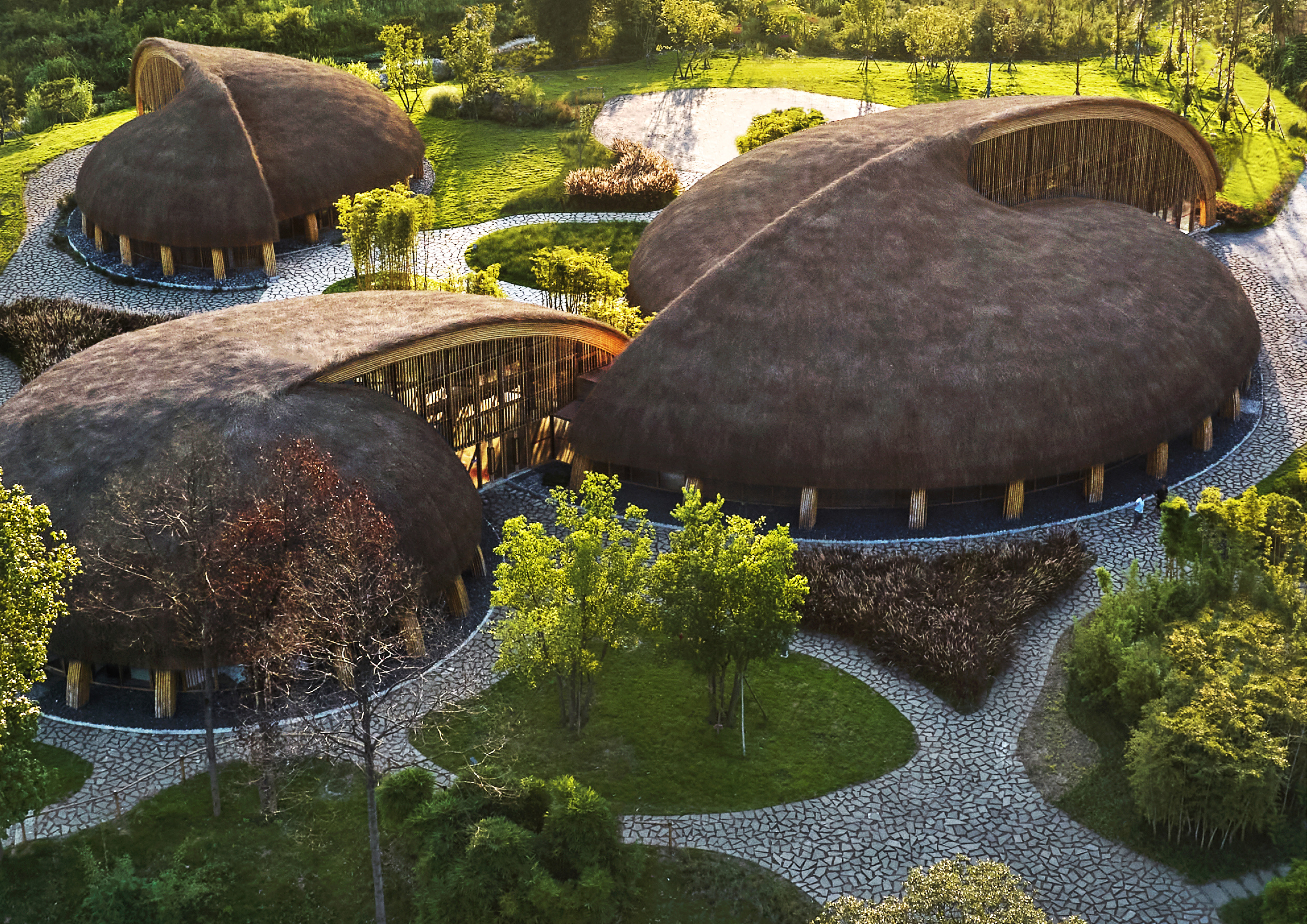
建筑散布于竹丛间-Three units scattered in surrounding bamboo groves

总平面图 Site Plan
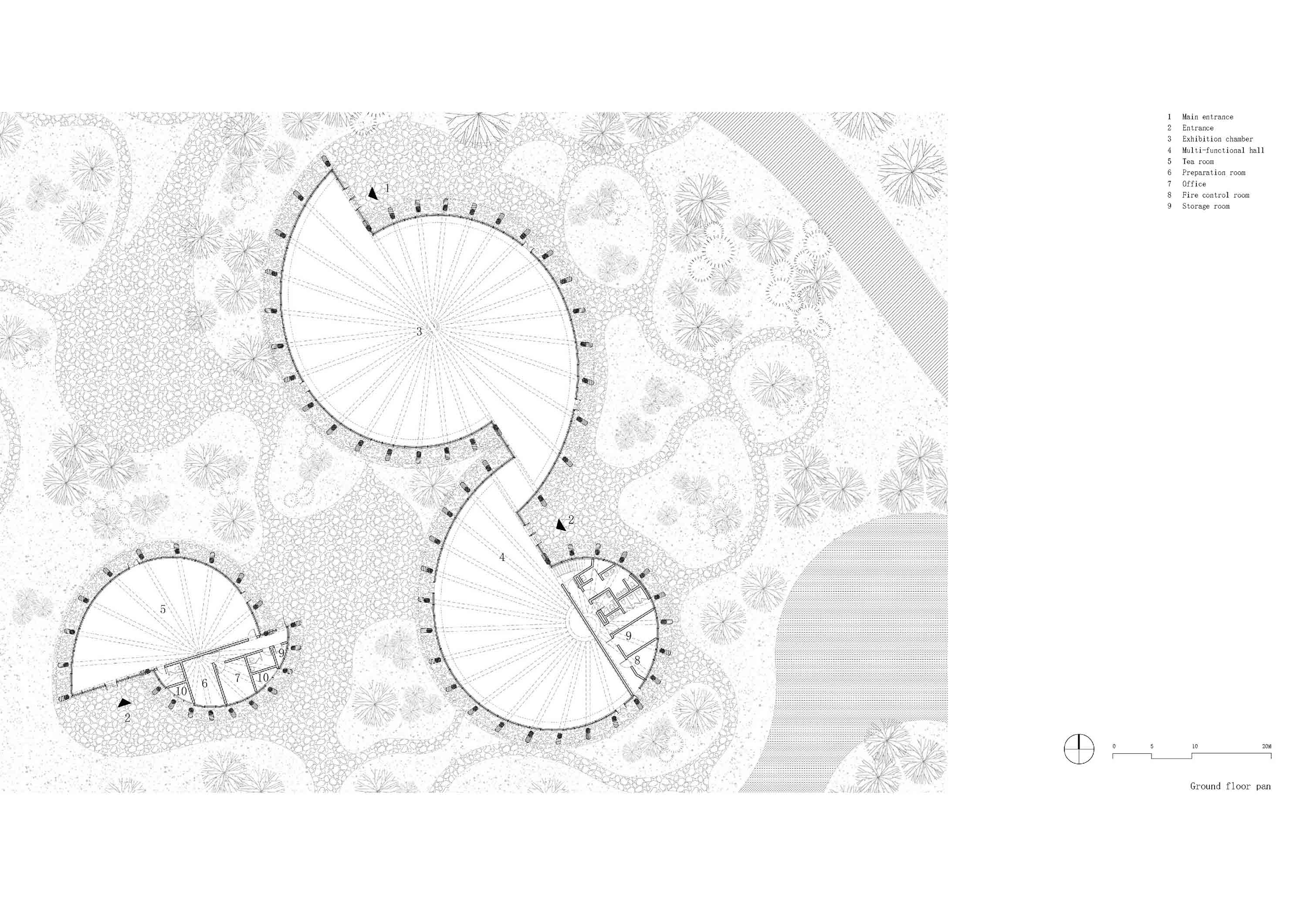
平面图 Plan

剖面图 Section
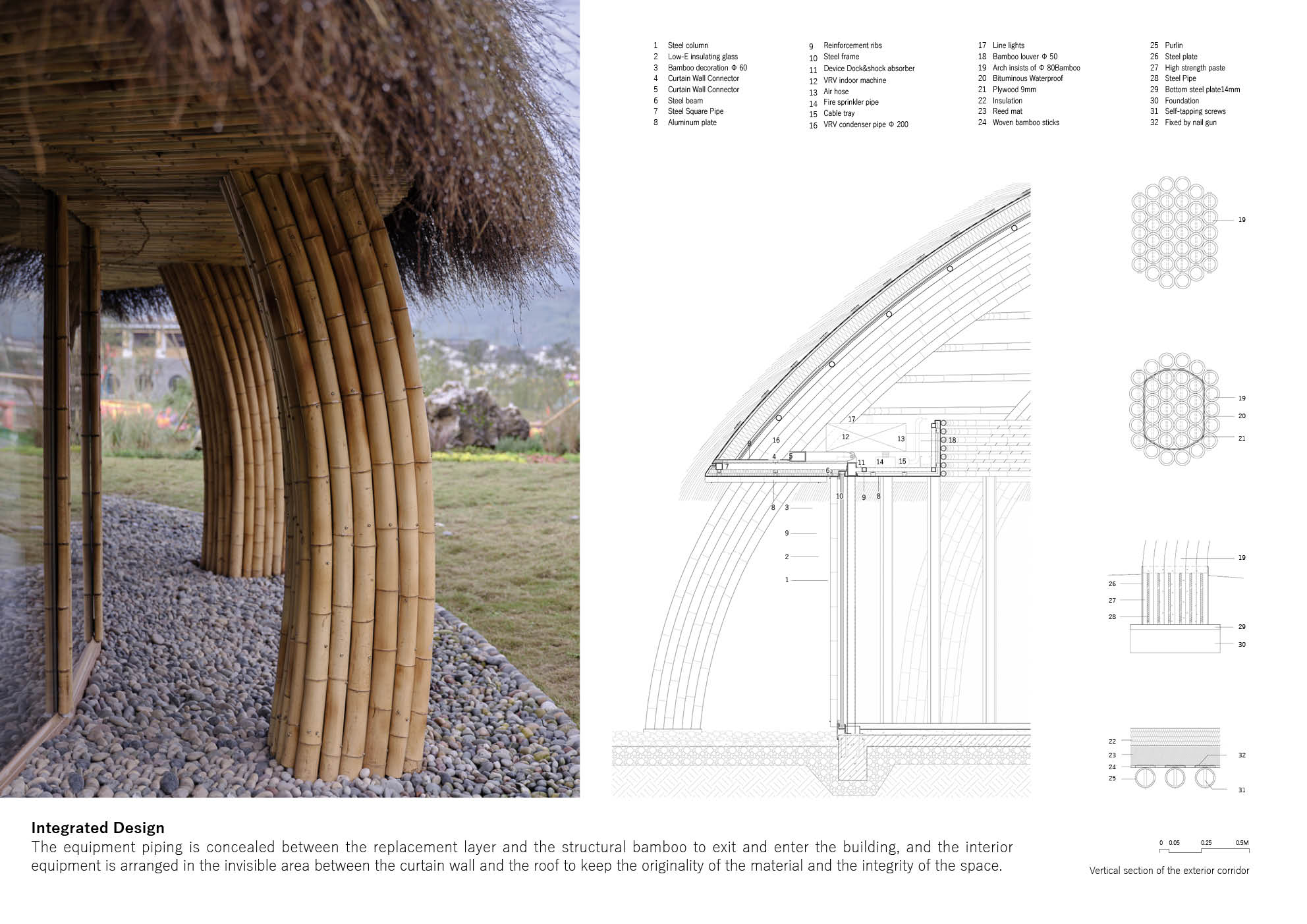
环廊剖面 Vertical section of the exterior corridor
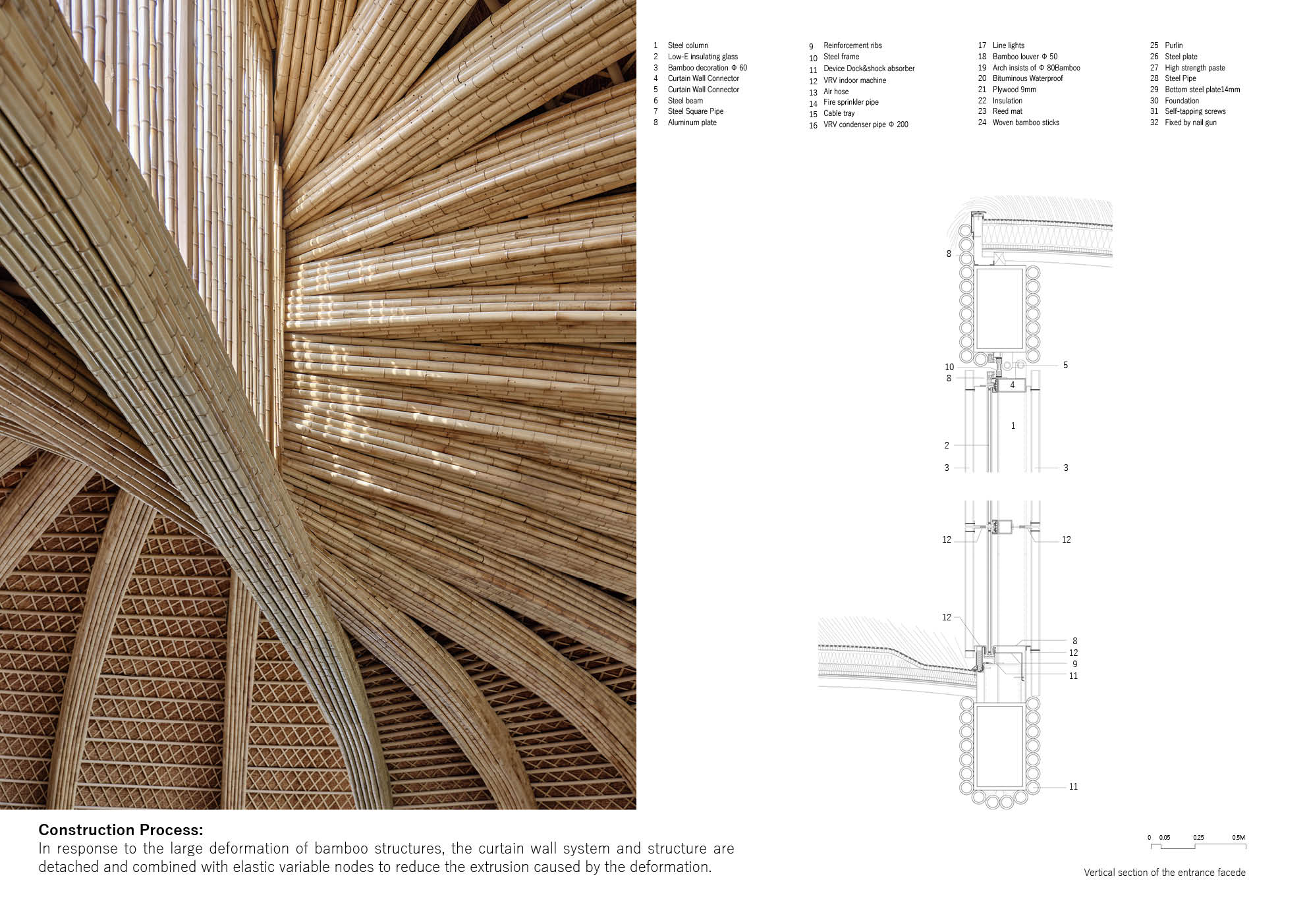
入口处剖面 Vertical section of the entrance facede
查看更多
 打开微信扫一扫
打开微信扫一扫






















